Singer 22 PATTERN, 8 PATTERN, 5 PATTERN, 16 PATTERN, 10 PATTERN Instruction Manual
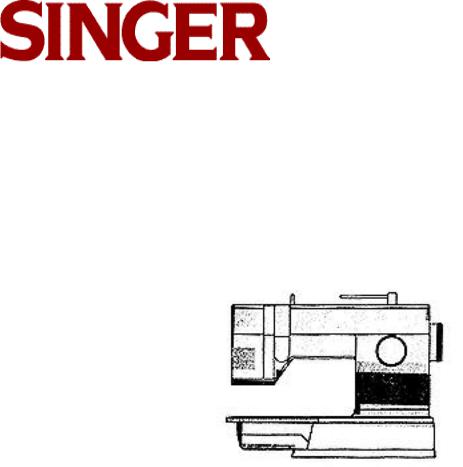
5, 8, 10, 16 & 22 PATTERN SEWING MACHINES
Instruction Manual

TABLE OF CONTENTS
Important Safeguards
1.Getting to Know Your Machine
Principal Parts Accessories
2.Getting Ready to Sew
Connecting the Machine/Running the Machine Choosing and Changing Needles
Free Arm Sewing Changing Presser Foot
Replacing Presser Foot with Shank Attaching Feed Cover
Winding a Bobbin Threading the Machine Inserting a Wound Bobbin Raising Bobbin Thread Selecting a Pattern
3.Straight Stitching
Preparation Sewing a Seam
Free Motion Embroidery Inserting a Zipper
4.Special Stitches
Preparation
Patterns capability and graphics illustration Zig-Zag Stitch
Zig-Zag Blindstitch Multi Stitch Zig-Zag
" M " Stitch/Sandcastle Stitch
Crescent Stitch/Chinese/Dynasty Stitch/Solid
Scallop Stitch
Arrow Stitch/Bunting Stitch/Privet Stitch
Wizard Stitch/Random Ric-Rac Stitch
Stretch Overedge Stitch
Ric-Rac/Straight Stretch Stitch
Road Runner/Fagoting Stitch
Honeycomb Stitch
Slant Overedge Stitch/Seagull Stitch
5.Four Step Buttonholing
6.Caring for Your Machine
Removing and Replacing Bobbin Case Removing and Replacing Light Bulb Cleaning the Machine
Performance Checklist Additional Accessories
Fabric, Thread and Needle Table
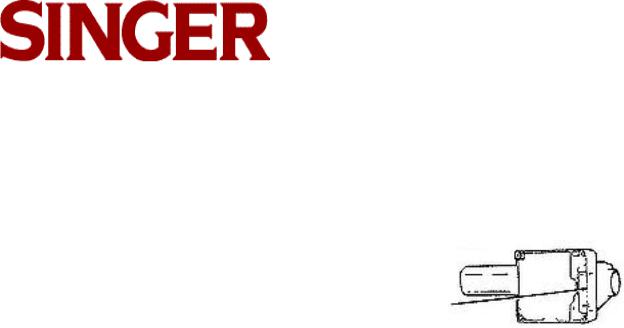
CONGRATULATIONS |
Dear Customer: |
You are about to begin an adventure in creativity: You are going to sew! And, you are going to sew with one of the easiest to use machines ever made.
The following features have been included on your machine, promising rewarding hours of uncomplicated sewing pleasure:
•Clearly defined thread path, reducing the possibility of threading errors.
•Built in buttonholer for fast, easy buttonholes.
•Slant needle designed do allow you to sit, see & sew better.
•One-step pattern selection, eliminating complicated selection operation.
In addition, this machine features a removable bed extension, permitting both flat and free-arm sewing; snap-on presser feet that are quickly removed and easily replaced; and a one-way needle-clamp that makes it impossible to put the needle in backwards.
Take some time to acquaint yourself with this owner's manual and your machine. Whether you are a novice or an experienced sewer, you will discover how easy it is to create something uniquely your own!
We recommend that for future reference you record the Serial Number of your Sewing Machine in the space provided.
Refer to illustration below for location of Serial Number on your machine.
Serial No.
Model No. ______________________
Serial No. ______________________
To ensure that you are always provided with the most modern sewing capabilities, the manufacturer reserves the right to change the appearance, design or accessories of this sewing machine when considered necessary.
*A Trademark of The Singer Company
3

IMPORTANT SAFETY INSTRUCTIONS
When using this machine, basic safety precautions should always be followed including the following: Read all instructions before using this machine.
DANGER
To reduce the risk of electric shock:
•The machine should never be left unattended when plugged in. Always unplug the machine from the electric outlet immediately after using and before cleaning.
•Always unplug before changing light bulb. Replace bulb with the same type rated 15 watts. Be sure to replace the face plate which covers the light bulb before operating the machine.
WARNING
To reduce the risk of burns, fire, electric shock or injury to persons:
•Be sure that the electrical voltage of the socket outlet (wall receptacle) is the same as the rated voltage of the motor.
•Use this machine only for its intended use as described in this Operator's Guide. Use only attachments recommended by the manufacturer as contained in the Operator's Guide.
•To disconnect, turn all controls to the off ("0") position, then remove plug from outlet.
•Disconnect the power-line plug from the socket outlet or switch the machine off when making any adjustments in the needle area, such as threading needle, changing needle, changing needle plate or changing presser foot, etc.
•Always unplug the machine from the electrical outlet when removing covers, lubricating, or when making any other user servicing adjustments mentioned in the Operator's Guide.
•Do not attempt to adjust the motor belt. Contact your nearest Service Center should any adjustment be required.
•Do not unplug by pulling on cord. To unplug, grasp the plug, not the cord.
•Handle the foot controller with care and avoid dropping it on the floor. Be sure not to place anything on top of it.
•Always use the proper needle plate. The wrong plate can cause the needle to break.
•Do not use bent needles.
•When sewing, keep fingers away from all moving parts. Special care is required around the sewing machine needle.
•Do not pull or push fabric while stitching. This may deflect the needle causing it to break.
•Before removing the bobbin case, remove plug from the socket outlet.
•For double insulated machines, when servicing, use only identical Singer replacement parts. See instructions for Servicing of Double-lnsulated Appliances.
•Never operate the machine if it has a damaged cord or plug, if it is not working properly, if it has been dropped or damaged, or dropped into water. Return the machine to the nearest authorized dealer or Service Center for examination, repair, electrical, or mechanical adjustment.
4

Safety Instructions continued...
•Never operate the machine with any air openings blocked. Keep ventilation openings of the machine and foot controller free from the accumulation of lint, dust, and loose cloth.
•Never drop or insert any object into any opening.
•Do not use outdoors.
•Do not operate where aerosol (spray) products are being used or where oxygen is being administered.
•Do not allow to be used as a toy. Close attention is necessary when the machine is used by or near children.
•SERVICING OF DOUBLE-INSULATED PRODUCTS. In a double-insulated product, two systems of insulation are provided instead of grounding. No grounding means is provided on a double-insulated product, nor should a means for grounding be added to the product. Servicing of a double-insulated product requires extreme care and knowledge of the system, and should be done only by qualified service personnel. Replacement parts for a double-insulated product must be identical to those parts in the product. A dou- ble-insulated product is marked with the words "DOUBLE-INSULATION" or "DOUBLE-INSULATED".
SAVE THESE INSTRUCTIONS
Servicing should be performed by an authorized service representative.
This product is intended for household use.
FOR EUROPEAN AND SIMILAR TERRITORIES:
This product is suppressed for radio and television interference with the International Electrotechnical Commission requirements of the CISPR.
Machines for Great Britain and some other countries having similar wiring standards are shipped from the factory with a plug for connection to the mains. The wires in this mains lead are coloured in accordance with the following code:
Blue: neutral (N) Brown: live (L)
As the colours of the wires in the mains lead of this appliance may not correspond with the coloured markings identifying the terminals in your plug, proceed as follows:
The wire which is coloured blue must be connected to the terminal which is marked with the letter N or coloured black. The wire which is coloured brown must be connected to the terminal which is marked with the letter L or coloured red. If a 13 Amp. (BS 1363) plug is used, a 3 Amp. fuse must be fitted, or if any other type of plug is used, a 5 Amp. fuse must be fitted either in the plug or adaptor or at the distribution board. Neither cord is to be connected to the earth terminal of a three-pin plug.
5
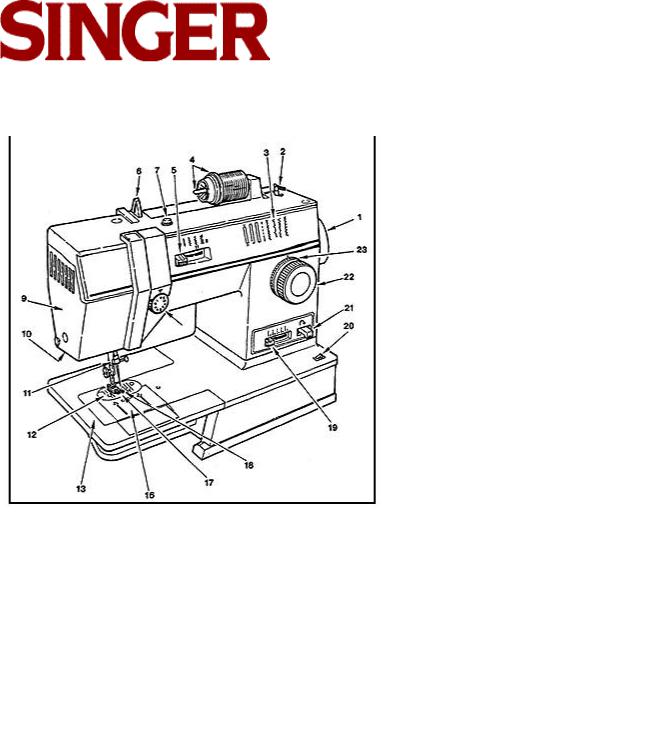
SECTION 1
GETTING TO KNOW YOUR MACHINE
9.Face Plate is a removable cover protecting movable parts and sewing light.
10.Sewing Light illuminates sewing area.
11.Needle Clamp holds needle in machine and prevents incorrect insertion.
12.Needle Plate supports the
13.Removable Extension Table lets you change the machine bed from flat to free arm.
16.Slide Plate opens for easy removal and replacement of bobbin.
17.Feed System moves fabric under presser foot.
Principal Parts
1.Hand Wheel provides a means for raising or lowering the needle.
2.Bobbin Winder lets you fill the bobbin with thread quickly and easily.
3.Pattern Display Panel shows a variety of patterns available for your sewing needs.
4.Spool Pin and Cap hold the top thread supply and allow it to unwind smoothly as the spool does not turn.
5.Stitch Width Lever controls the width of patterns and sets the needle for straight stitching.
6.Snap-In Thread Guide helps to insure a smooth flow of thread from the spool of tension.
7.Bobbin Winder Tension Disc provides thread tension for bobbin winding.
8.Needle Thread Tension Dial controls top thread tension.
18.Presser Foot holds fabric against the feed system and snaps on and off.
19.Stitch Length Lever allows for a variety of stitch lengths.
20.Power and Light Switch turns on the machine and sewing light at the same time.
21.Reverse Lever provides either momentary or continuous reverse fabric movement.
22.Reverse Lever provides either momentary or continuous reverse fabric movement.
23.Pattern Selector Dial turns directly to any of the pattern display panel.
6
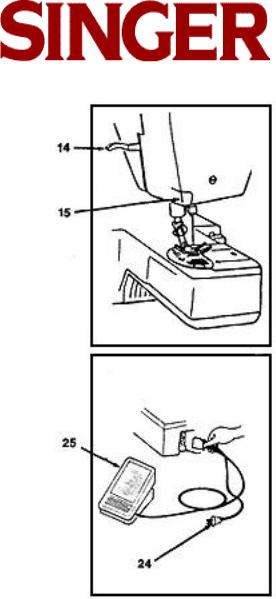
Principal Parts Continued...
14.Presser Foot Lifter, at the back of machine, lets you raise and lower presser foot.
15.Thread Cutter
24.Electrical Power Cord connects machine to your electrical outlet.
25.Speed Controller regulates the sewing machine speed. fabric during sewing.
7
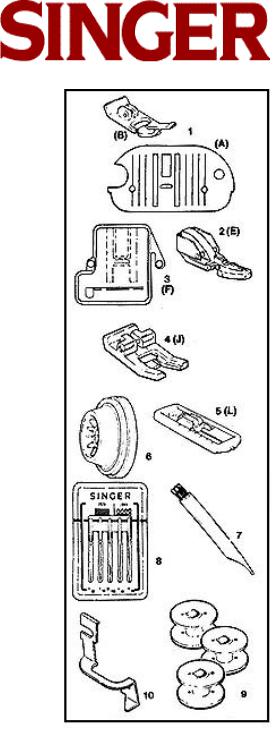
ACCESSORIES
The accessories for your machine are designed to simplify many of your sewing projects.
1.General Purpose Needle Plate (A), and Presser Foot (B), are standard on the machine. Used for straight and zigzag sewing.
2.Zipper Foot (E), for inserting zippers.
3.Feed Cover (F), used for button sewing, free motion work and darning. It keeps the feed from moving fabric.
4.Special Purpose Presser Foot (J), used for decorative and zig-zag stitching.
5.Buttonhole Presser Foot (L), used to make fourstep buttonholes.
6.Spool Holder, for medium and large thread spools.
7.Lint Brush, for cleaning the machine.
8.Needle Pack, includes an assortment for sewing various types of fabrics.
9.Bobbins, transparent for easy viewing.
10.Blindstitch Hem Guide, is used to position the hem for blindstitch hemming.
8
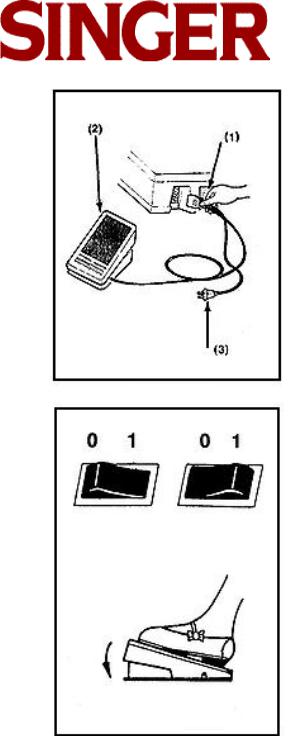
SECTION 2
GETTING READY TO SEW
CONNECTING THE MACHINE
Before plugging in your machine, be sure that the voltage and number of cycles indicated on the electrical data table (1), conform to your electrical power supply.
Plug the controller (2), into the receptacle, at the right end of the machine.
Then connect the electrical power cord plug (3), to your electrical outlet.
Do not operate machine without material under the presser foot as this may damage the feed and the foot.
RUNNING THE MACHINE
The machine and the sewing light are turned on and off by the same power switch.
POWER SWITCH
Power on-press "1" side of switch. Power off-press "0" side.
To run the machine, press the speed controller. The harder you press, the faster the machine will sew.
To stop the machine from sewing, remove pressure from speed controller.
9
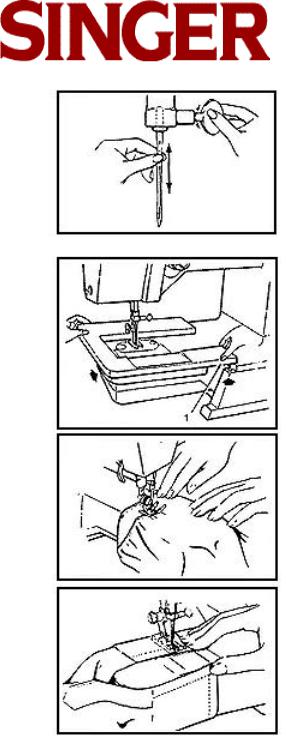
CHOOSING AND CHANGING NEEDLES
IMPORTANT: For best sewing results, use only Singer * needles. Check the needle package, and the Fabric, Thread and Needle Table for the correct needle and fabric combination.
•Raise needle to its highest position.
•Loosen needle clamp screw and remove needle.
•With flat side of, needle to the back insert new needle up into clamp as far as it will go.
•Tighten needle clamp screw securely.
FREE ARM SEWING
Free arm sewing makes it easier to sew hard-to-reach areas.
To change machine for free arm sewing, push in and lift right edge (1) of extension table, slide it to the left and off the machine.
•Topstitch edges on sleeves, or finish waistbands and pants legs easily.
•Sew buttonholes without stretching cuffs or neckbands.
10
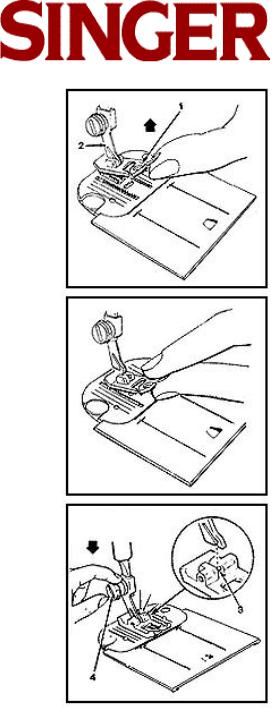
CHANGING THE PRESSER FOOT
(B) (E) (J) (L)
Your machine comes with the General Purpose Presser Foot already attached. You can easily change to any one of the other presser feet which snap onto a common shank by following the directions below.
•Raise needle to its highest position by turning hand wheel toward you.
•Raise presser foot using presser foot lifter in back of machine.
•Push toe of presser foot (1) up, until it snaps off the shank (2).
•Take foot off machine.
•Place new foot under center of shank.
•Lower presser foot lifter, fitting shank over presser foot pin (3).
•Don't turn screw. Instead, push presser foot screw4() down firmly until foot snaps into place.
11
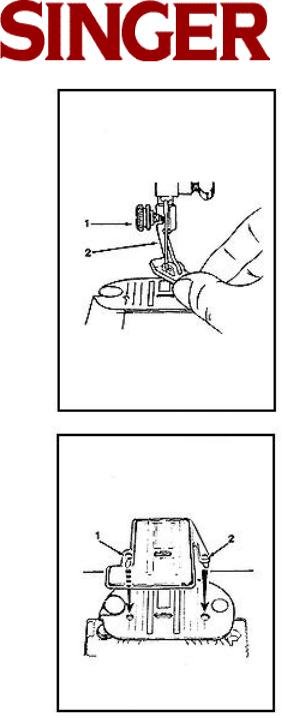
REPLACING PRESSER FOOT WITH SHANK
Presser feet with built-in shanks can be replaced as follows:
•Turn machine off.
•Raise needle and presser foot.
•Loosen presser foot screw (1) and remove presser foot with shank (2), guiding it toward you and to the right.
•To replace presser foot with shank, hook shank around the presser bar and tighten presser foot screw.
ATTACHING FEED COVER (F)
The feed cover keeps the feed from moving the fabric.
•Raise needle and presser foot.
•Open slide plate.
•Slide feed cover on top of needle plate, pressing tabs (1) and (2) into holes.
•Close slide plate.
•To remove, open slide plate and lift front edge of cover; pull it away.
12
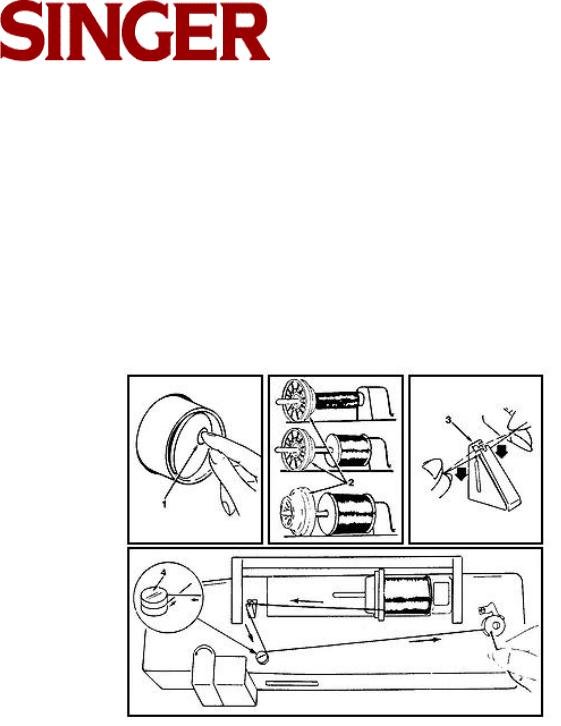
WINDING A BOBBIN
Winding a bobbin is quick and easy when you follow the directions below. Always wind the bobbin before threading the machine.
•Push in indent (1) on hand wheel disc. This will stop the needle from moving.
•Place spool of thread on spool pin.
•Slide spool cap (2) firmly over rim of spool to prevent thread tangling.
•Lead thread from spool and snap into thread guide post (3).
•Wind thread clockwise around front of bobbin winder tension disc (4).
•Pass thread end, from inside, through small hole in rim of bobbin.
•Place bobbin on spindle and push it to the right.
•Holding thread end, step on speed controller to run machine until desired amount of thread is wound.
•Cut thread; push bobbin to the left and remove it from spindle.
•Trim thread end from top of bobbin.
•Return hand wheel disc to sewing position by pressing on side opposite indent.
13
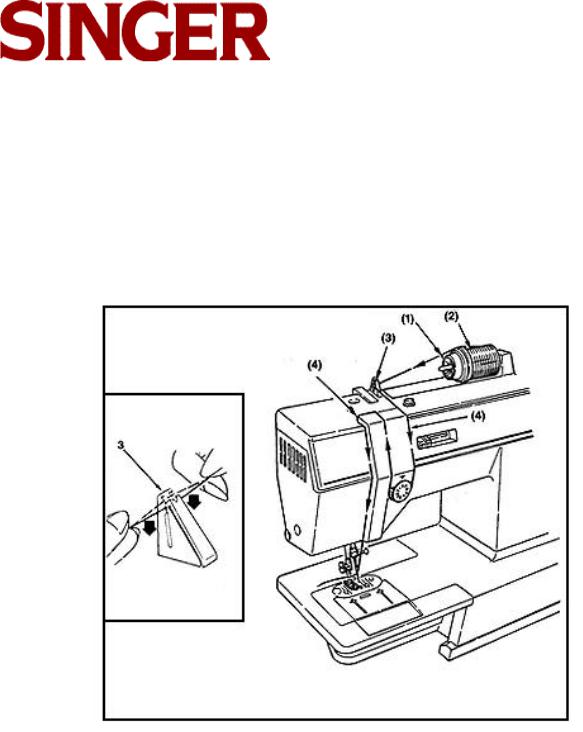
THREADING THE MACHINE
Your sewing machine is easily threaded. The clear threading path helps you avoid threading errors.
To thread your machine correctly, simply follow the steps below:
•Raise presser foot lifter.
•Raise needle to its highest position by turning hand wheel toward you.
•Place spool of thread on spool pin (1).
•Slide spool cap (2) firmly over the rim of the spool to prevent thread tangling.
•Snap thread into thread guide post (3).
•Following arrows, guide thread into threading channel (4) down to needle and firmly pull thread.
•Thread needle from front to back.
14
